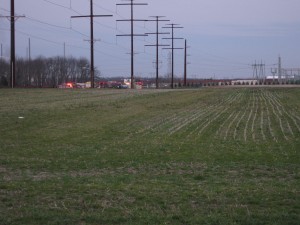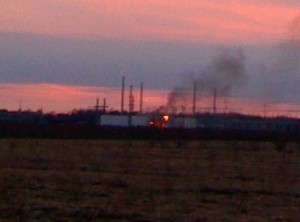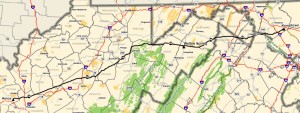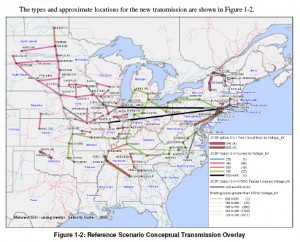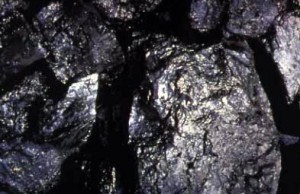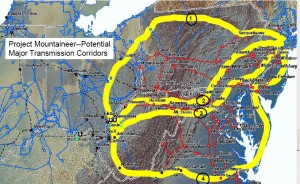FIRE! ACE’s Orchard substation is on fire!
December 14th, 2009
“HOT” off the press from Stop the Poles! The Atlantic City Electric substation in southern New Jersy went up in flames today.
And as to the article below, keep in mind that this is one big honkin’ substation — “distribution” — I don’t think so…
How does a substation burn?!?!?!?!?! Apparently it’s the plastic wall around it that’s on fire, the “sound” wall, but how could that be? How could that burn? And I’ve heard that emergency crews can’t get near it,they’re on the scene, but aren’t allowed to get close. That’s them banded together to the left of the line, and that’s the substation on the left. Must be pretty intense toxic emissions?!?!?!
Here’s another photo:
Fire reported at Atlantic City Electric Co.’s Orchard Substation in Upper Pittsgrove
By Today’s Sunbeam
December 14, 2009, 4:36PMSeveral Salem County fire companies have been called to the scene.
Heavy smoke to could be seen in the area.
The cause of the fire is still unknown.
The new station is part of Atlantic City Electric’s power distribution network in South Jersey.
Rough path for PATH
December 11th, 2009
Difficulties are growing for “backbone” transmission for coal in the east. Not long ago, Virginia staff had asked the Commission to deny the PATH proposal. Now, after the hearing ended, after reviewing testimony, staff has again recommended the petition be denied. This is the project where Maryland tossed it out because the applicant was not a public service corporations. If one end of the project is taken out, it’s a project going nowhere.
West Virginia declined to dismiss the application, and instead has taken action, or taken inaction:
Now it’s time for Virginia’s reality orientation.
Va. staff again recommends denial of PATH project
Originally published December 11, 2009
By Ed Waters Jr.
News-Post Staff“The public regulatory review process in Virginia is extremely thorough and has a long way to go. The PATH evidentiary hearings before the Virginia State Corporation Commission are scheduled to begin in Richmond, Va., on Jan. 19, 2010, and are expected to last about two weeks,” Meyers said.
Read the rest of this entry »
Go to NoCapX 2020!
December 11th, 2009
I know, there’s nothing here!! That’s because everything is happening the last two weeks at NoCapX 2020! We’ve been having transmission line hearings all across southern Minnesota, and there’s not much time for anything else. So do check out the NoCapX site… there are a few tidbits piling up, but it’ll be a while before I get to the inbox!
Offshore transmission, NOT transmission from Midwest
December 6th, 2009
By standing up for offshore transmission for wind, Delaware’s Gov. Jack Markell stands up to Midwest coal!
The Mid-Atlantic states have been standing up and opposing transmission from the Midwest. They’ve gone on record in a number of venues, and in their opposition are citing Midwest transmission promoters’ disregard for eastern renewable efforts, that xmsn may well not be an economical way to get power to the east, and that THEY KNOW THAT MIDWEST TRANSMISSION PLANS INHERENTLY ARE ABOUT COAL. The plan they’re referring to is a massive transmission buildout known as JCSP, and it also applies to the big PJM buildout that includes the PA-NJ Susquehanna-Roseland transmission line that was the subject of a hearing last month.
Here’s JCSP (Joint Coordinated System Plan) note their site now talks about wind — but look where the transmission starts, DUH! The coal fields of the Dakotas:
Gotta give them, Delaware, Maryland and Virginia, a lot of credit for recognizing and stating what Midwest states have been unwilling to admit.
That said, here’s what Mid-Atlantic states are doing — they’re banding together to propose offshore transmission. If it’s underwater offshore transmission, that’s an idea that’s hard not to like. But I’ll bet it throws PJM for a loop, what with all their “backbone” transmission schemes, a la Project Mountaineer, that are in the works:
The FERC birth of Project Mountaineer:
And you can see that those lines in play now, PJM’s “backbone” transmission projects like Susquehanna-Roseland (NE part of Project Mountaineer Line 1) and MAPP (NE part of Project Mountaineer Line 4) are part of the plan… the big transmission plan that does not work for the east coast.
Here’s the Memorandum of Understanding between Delaware, Maryland and Virginia:
And recently, Gov. Jack Markell addressed these issues before American Wind Energy Association’s offshore windfest — but given the PJM big-transmission-projects-from-hell are referred to as “backbone” projects, I wish they’d find another term:
Delaware energy: ‘Backbone’ power line pushed for wind farms
By AARON NATHANS
The News JournalGov. Jack Markell broached the subject this week in his address to the American Wind Energy Association’s offshore wind workshop, the industry event of the year on this side of the Atlantic. Markell signed onto letters the governors sent to members of Congress this summer, and the Federal Energy Regulatory Commission last month.
“Let’s have the conversation,” O’Mara said. “It’s extremely worthy of further study.”
“It obviously won’t happen in the absence of federal leadership,” he said.
Fishermen’s Energy President Daniel Cohen said it’s a good idea, but “it’s another moving part.”
The benefits of building lines transmitting wind power from the Midwest are less certain, he said.
“It will be difficult to get progress in this area until there are clear national goals,” he said.
Note that “cost allocation” is raised. Since the 7th Circuit decision tossing out FERC approval of PJM’s transmission cost allocation dream/nightmare, all transmission projects 500kV and over based on that cost allocation scheme are in limbo.
So as noted, who pays, and submarine transmission is EXPENSIVE, is THE big issue now. It’s the big issue for land transmission, it’s the big issue for offshore transmission, and, given the uncertainty since the 7th Circuit decision, maybe some of the sturm and drang could be circumvented if it’s designed at 345kV or below, and uses the “benefactor pays” theory. We shall see…
Pipelines in the news… spill in Staples
December 4th, 2009
… and then there’s eminent domain!
First the spill, it’s “breaking” news, 210,000 gallons at least all over Staples, where a crew was “working” on the line. This is, I believe, the old lines, not the new 24″ MinnCan pipeline right nearby:
Oil pipeline leak spills 210,000 gallons near Staples
By BOB VON STERNBERG, Star TribuneLast update: December 4, 2009 – 4:13 PM
The pipeline was immediately shut down, Chapin said.
The leak occurred in a wooded rural area about three miles southeast of Staples.
Assisting the state agency with the pipeline safety arm of the U.S. Department of Transportation.
A truck designed to vacuum up the spill arrived at the site this afternoon, she said.
Here’s the eminent domain news about a pipeline — tired of waiting around for “compensation” from the takers — one guy did what how many others want to do? And “Engelking” … I wonder… is this guy any relation to Betsy Engelking???
Wis. man arrested for trespassing on his own land
Last update: December 4, 2009 – 8:37 AM
Jeremy Engelking of Superior is expected to appear in Douglas County Circuit Court Friday.
